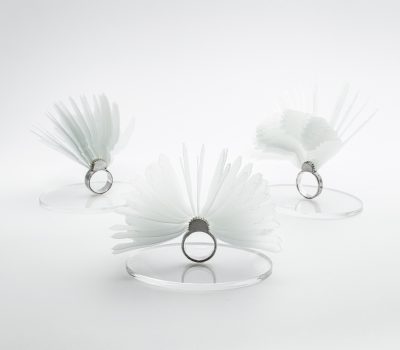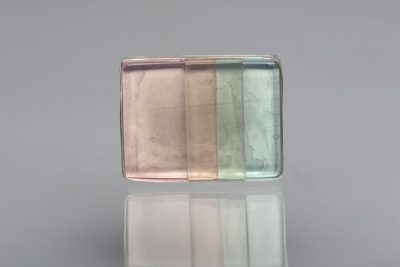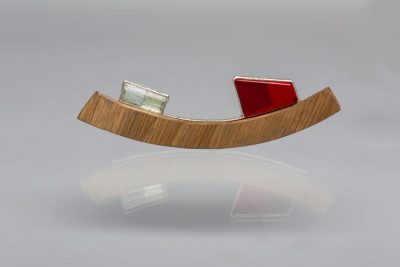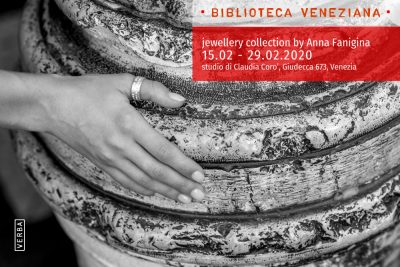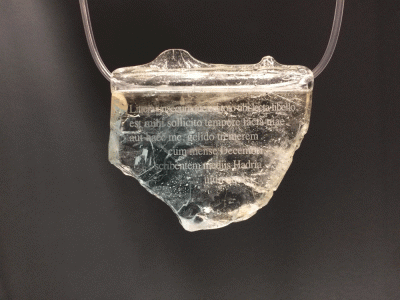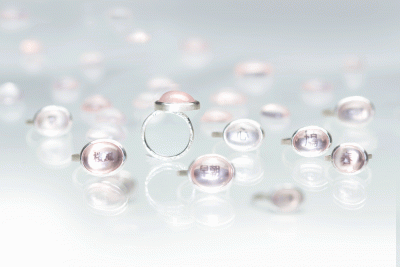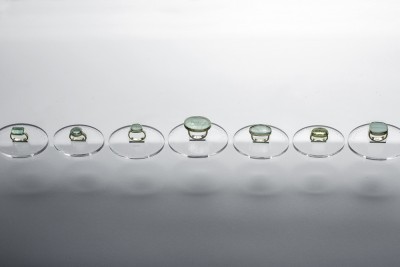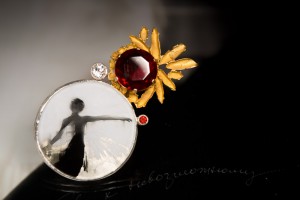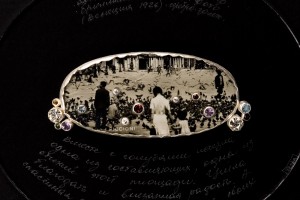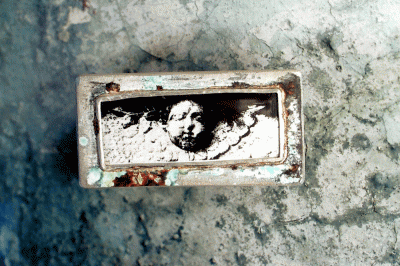DIENASGRĀMATA/DIARY, 2021
Latvian Jewellery Art Association organised an exhibition “Dienasgrāmata”, for which VERBA designer Anna Fanigina has created a special ring collection CAPRE DIEM (lat. “seize the day“). The artist herself explains: “Birds have become the protagonists of my “diary”, I watch them every day from the window of my apartment, and when I spot a special and unseen bird, I write it down. I have almost 30 types of birds on my list. The “observation diary” was already a passion of mine at school and the last year encouraged me to return to it. The CARPE DIEM collection is also a tribute to the origins of the diary as a genre that originated in Japan in the 11th century and only later found its way to China and Europe. This genre was born not only from the development of human individuality, but also from the invention of common objects such as paper and clocks. Each ring in the collection is a kind of bird-diary, a reminder of the preciousness of each day and that life passes by very quickly. It gives the wearer wings and lightness, inviting them to fill the pages and “catch the sparrow by the tail”.”
The Diary project is a recording of 19 jewellery artists’ latest original works in video and photo formats, in which the artists offer viewers their diary pages in the form of jewellery, created especially for this project, through which to search for truth, feel a sense of community and find new interpretations.
ZĪME/MARK, 2020
The collection of three pins PRIMUS, SECUNDUS, TERTIUS was created for Latvian Jewellery Art Association exhibition ZĪME/MARK, which took place in Rothko center in Daugavpils. Jewelry is made of silver, but the means of expression has become the interaction between natural and artificial materials – organic glass and semi-precious stones. At first the difference between the materials is difficult to notice. Pink quartz, aquamarine, citrine versus colored plastic is not so easy to determine on the first eyesight. The artist uses the color palette of the Pompeii murals, choosing the softest and brightest tones of the spectrum. The cultures of ancient civilizations, and especially antique wall paintings, which were a core value in Mark Rothko’s art, are also a constant source of inspiration for Anna Fanigina. “When I received the invitation to take part in Mark Rothko’s exhibition, I began researching his life and work to find points of connection, and quickly realized how important antique art was to him. It also means a lot to me. I participate in archaeological expeditions in Pompeii every year and I have a unique opportunity to “communicate” with Roman frescoes without intermediaries. Gently cleaning the Roman wall and surfaces together with the restorers and being in contact for several days makes one appreciate the special coloring of the frescoes and the unresolved secrets of the technique. Time-honored they have an even greater artistic value and makes one fall in love with these walls for life.”. Three rectangular pins with delicate, rounded outlines stand for small, symbolic cut-out fragments of the ancient walls. They reveal the ancient trace of love as well as gratitude to Mark Rothko for another opportunity to delve into the colors and shine within light and power.
μελαινῶν νεῶν κατάλογος (“The Catalogue of Black Ships” in Antient Greek), 2020
A collection of four brooches for the international project GOODWOOD was presented at the exhibition in Saint-Peterburg from February 8 till March 8, 2020. There are no random lines, but mathematical formulas behind each bend, the laws of ergonomics and movement on water in each curve. The wooden fragments used in the jewelry are the pieces of valuable wood species (elm, cherry, oak) specially chosen at the gondolas shipyard in Venice. Each of them reflects the geometry and elegance of these unique boats in a small drop. The name of the collection is a reference to the second part of the Iliad of Homer. The Homeric ships were black, and Venetian gondolas remain black to this day. The wooden details are complemented by red plexiglass and blue aquamarines – one of the most expressive color contrasts encountered in Venice during regattas. This collection is a symbolic greeting to St. Petersburg from Venice, because the designer’s geographical movements often lie exactly on the axis between these two cities. And it is also a research on the theme of water and movement, this time using wood.
BIBLIOTECA VENEZIANA, 2020
Exhibition BIBLIOTECA VENEZIANA (“Venetian library” in Italian) took place in February 2020 in studio Claudia Coro’ in Venice during the Carnival, one of the most vibrant celebrations of the year. The installation of 20 symbolic books, which are flying in the air or floating during the floods, make the “Venetian library” consisting of jewelry with literary quotes about Venice. Jewelry is made of silver and photoceramics with architectural motives, but the main information carriers are elements made of red plexiglass, which creates the leitmotif of twenty writers and poets – Marcel Proust, Ivan Bunin, Paul Morand, Nikolay Gumilyov, Thomas Mann, Joseph Brodsky, George Gordon Byron, Jorge Luis Borges and others. All these fragments are united by one thing – love, admiration, astonishment and gratitude for this unique place called Venice.
EPISTULAE, 2019
The collection is based on the impressions of reading Ovid’s “Letters from Pontus” and “Sorrowful Elegies”. In the 1st century A.D., the Roman poet was exiled to a distant city on the Black Sea coast, to the outskirts of the civilized world, where he closed his days. All his pain, loss, loneliness and perceived unfairness were poured out in his last poems. However, in these same poems we see the invariable strength of the spirit, the readiness of culture to resist a hostile environment, the inextinguishable hope of deliverance, inner freedom, the confidence that the woes embodied in verse will remain in history and art for centuries, and this is their great value and victory.
A collection of pendants made of transparent, almost untreated topaz, aquamarine and quartz with laser engraving of Ovid’s poems was created for installation in the National Archaeological Museum of Adria (Italy) in 2019, where it was exhibited together with vessels made of ancient Roman glass from the 1st century A.D. Each piece corresponds to its own vessel, giving a reference to the tradition of sending letters in bottles to the sea for future generations. Transparent pendants look like petrified waters of the raging elements, through which the poet risked his life to reach the place of exile, or like pieces of ice, first seen and amazed the poet in the north, or like frozen accumulated tears that turned into poems. This is a conversation about the transformation of the fragile and strong, fluid and solid, eternal and fleeting. This collection was presented at exhibition ORNAMENTA II 2019: Jewels between history and design. The main idea of ORNAMENTA II was that contemporary jewelry is shown side by side to ancient glass objects especially exhibited for the occasion.
SAKURA, 2019
“One wind for a thousand miles” (metaphor of the world). Collection by Latvian designer Anna Fanigina is dedicated to blooming sakura. Each ring embodies a blossom — flying in the wind, carrying a message in Latin, Ancient Greek or Japanese. As an antique metaphor of peace and harmony says, “One wind for a thousand miles” is blowing, banding different ages and cultures. All collection rings are handmade from silver and natural stones: rock crystals, topazes, rose quartzes.
νεῶν κατάλογος* (“The Catalogue of Ships” in Antient Greek), 2016/2017
Every ring as it were ship, that could float away together with you or stay on your finger as a great friend, struggling against the waves of daily worries and aspirations. Each ring is branded with its own „watermark” – a phrase in Greek, quotation or just with some words on simple and proper things for all times – fair wind, strong canvas, courage, love and joy. That’s what we are always full of after visiting the seaside, trying to keep this feeling long after being back from the journey, and this is how we could steal a page from Ancient Greek’s book.
These inscriptions in Greek are made with micro-chase technology, as mostly marine stones are used in this collection – aquamarines, as well as heliodors, chrystolites and quartzes.
The marine theme additionally described with handmade glasse, made by special order using blow technique, furnished with sending ups on the language of Ancient Greeks.
Since Anna Fanigina created VERBA jewellery brand, her claim to fame and essential became inscriptions in Latin. As soon as the history of this brand is more than ten years now, the long-desired Greek collection has come, so let it be the only start of exciting journey.
* “The Catalogue of Ships” is an epic list from Homer’s Iliad Book two (“song”).
L’AMOUR DE L’IMPOSSIBLE, 2012
“L’amour de l’impossible” – is a collection of silver brooches made by employing photos, natural stones and vintage glass. Time itself has made antique glass precious, aside, used pieces of old jewelry are like quotes that make a connection with the aesthetics of our mothers and grandmothers’ brooches. In her jewelry collection L’Amour De L’Impossible the author continues to explore themes of brooches as a special decoration that has “the right to invade” the fabric of our clothes and symbolizes a kind of vivid and poignant impression. At this time, those heightened senses and unique experiences are those that bring the art of ballet, constantly pushing the boundaries of the possible, causing a desire to “pin them into the heart” and take it with you, save it for a long time, share it with others and inspire yourself to the impossible. And “love the impossible” is the driving force that allows the unreal becomes real. The project was created parallel to the work on the ballet “Romeo and Juliet” directed by maestro Nacho Duato in collaboration with artist – photographer Yuri Molodkovets and timed to coincide with the premiere in the Mikhailovsky Theatre in Saint Petersburg (Ru).

